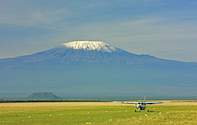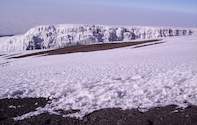
Kilimanjaro is a word that comes from the local Wachagga tongue; it is something ova metaphor implying a journey that has no ending. It is meant to imply you cannot reach the top, for any one of several reasons.
The first is the obvious one, that it is extremely hard for an untrained human to reach that altitude. The other being that, although positioned a fraction south of the equator, it is extremely cold around the summit cone and East Africans are especially afraid of cold. Another reason lies in the realm of the supernatural, the fact that high mountains the world over are associated with spirituality, often regarded as the domain of gods and Kilimanjaro is no exception.
To venture to the summit would be an affront to the local mountain gods. In 1848 a German missionary was the first to record the presence of a hive mountain in the heart of the East African plains. Johann Rebmann saw a gleaming white summit, described by Wachagga tribesmen as baridi (cold).
The first serious endeavour to scale the mountain was in 1861 by the German explorer Baron Carl Claus von der Decken and a young English geologist Richard Thornton, but they reached only 2,500 metres. A year later, von der Decken tried again and managed to reach 4,280 metres. Following that there were numerous other attempts to reach the summit.
Then German geographer Hans Meyer arrived in East Africa in 1887 to give it ago. In all he tried three times, the first time being defeated by the altitude and the second time by a local uprising against the German-East African Society's attempts to depose Islamic rule on the Swahili coast.
Finally, in 1889, in the company of crack Alpinist Ludwig Purtscheller, he succeeded in standing atop Kibo, on what is today known as Uhuru Point, at 5,895 metres above sea level. The climb was much higher than anything comparable in the Alps by more than 1000 metres. Even today a hike to the summit requires extreme commitment and good mountaineering gear.
Ice on the Equator

Africaphile John Reader writes in his book Kilimanjaro: "The distance up is about 3,300 metres - the equivalent of nine Empire State Buildings laid end to end up the incline. The climb is not extreme in mountaineering terms; you could say it is equivalent to scrambling up a staircase rather more than three kilometres long. But then at 4,710 metres, where the final ascent begins, there is little more than half the density of oxygen that occurs in Manhattan or at the foot of most staircases. So, in effect, the aspiring climber attempts the equivalent of those feats with the equivalent of only one lung."
Rebmann's and other subsequent claims of seeing ice on various mountains near the African equator (Mount Kenya and the Ruwenzori's being the significant others) were dismissed by the Royal Geographical Society: "Quartz," they insisted and arrogantly downgraded these explorers' exploits. The Maasai who occupy the surrounding savanna plains calls the mountain Ol Doinyo Naibor, "the white mountain", or NgajeNgai, "the house of god" (similar to its nearby twin Ol Doinyo Lengai). For people with no concept of snow or ice, the summit did appear to be the kind of place where a god might dwell.
When it was first climbed the entire upper cone of Kibo was covered by an ice cap, with glaciers cascading down its colder western and southern flanks, as well as cascading far down the Western Breech Wall (first climbed by the incomparable Reinhold Messner), Between then and now, however, the ice capping has retreated to Just 10 percent of its former extent.
Today you might climb Kili" without ever touching snow, let alone ice. Snowfalls can still, however, be prodigious. While this receding of the glaciers is frequently held to be among the most visible proof of global warming (and it is), it must be borne in mind that climate is cyclical and that the Ice cover on the mountain has expanded and contracted numerous times since the mountain formed on the edge of the Great Rift Valley around 10 million years ago.
Core samples taken from the mountain's Northern Ice Field, inside the summit caldera, show an age of only 12 000 years, before which it was clearly devoid of an ice covering. At current estimates, most of the summit ice will be gone by 2040, with virtually no chance of there being any ice to cool your celebratory summit drink by 2060.
By David Bristow

 Kilimanjaro is a giant volcanic mountain located in Tanzania, and comprises of 3 distinct volcanic cones. This spectacular natural wonder...
Kilimanjaro is a giant volcanic mountain located in Tanzania, and comprises of 3 distinct volcanic cones. This spectacular natural wonder...